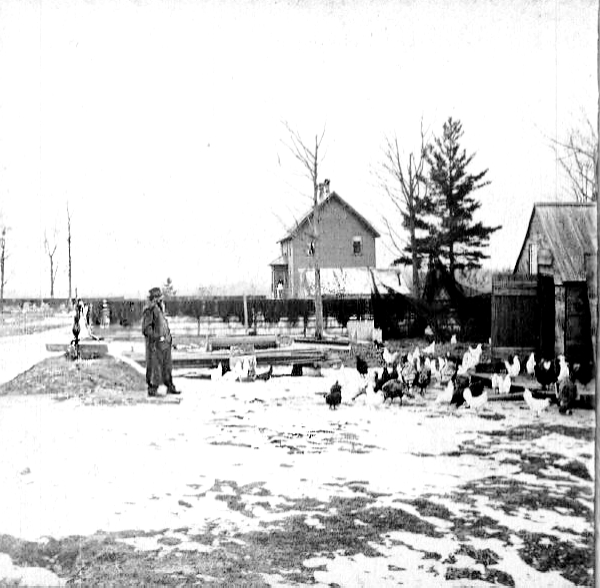TOWN
of
OCONTO
Oconto County
Wisconsin
|

Fishing nets and
poultry
Late 1800's
Photographs of the many fisherman,
their homes and their families who settled along the Town of Oconto
Lake
Michigan shoreline are rare. Fishing was an important industry early in
the county's history. In this old photo of a very proud fisherman and
his
three children, the nets are hanging to dry in the background. Writng
on
the back of the photo says
"Our
little farm near Green
Bay shore. Chickens and fishing nets." |

Fisherman's
Farmhouse
Late 1800's
The same hard working fisherman
is seen from a different direction in this photograph, which includes a
view of his fine garden area and spacious comfortable home. Look
closely
at the front porch of the farmhouse and you will see the wife posing
for
the photo. Writng on the back of the photo says
"See our house and the fishing
nets storing on the fence." Both
photos are
engraved with "Oconto Wis". The family name is not known. |

Oconto River
empties into the Green Bay of Lake Michigan
The mouth of the Oconto River is
two miles downstream of the city of Oconto. Marshland and wild rice
plants
made up most of this area. A "jacknife" trading post, so named because
it "closed up" in winter, was built during fur trading times at the
mouth.
The first permanent settlers in the 1840's could not enter the river
because
of the thick mats of waste sawdust from the sawmills that were dumped
into
the river upstream. Mrs. Lindsey wrote that it was so thick in places a
man could walk on it. It was hard work and costly to haul everything up
stream and the mills eventually began burning the waste.
|

Coney Island
Seen from off shore.Town of Oconto
had it's own "Coney Island", complete with fishing boats and rowboats,
fish shanties where the catch was processed and curious
visitors.
Commercial fishing at first brought in White Fish, Herring and Trout in
the 1860's, which were salted and packed in barrels for shipping to
Eastern
commerical centers. Later fishermen from Norway settled with their
families;
Anderson, Benson, Gabrielson, Hagsfors, Johnson, Laxfors Lundemo, Skog
and Valryg. There was one Swedish family, Wickenberg. Fish shanties
were
hauled out on the ice for winter. Sail sleighs were used to bring the
catch
to shore and sometimes attained speeds of 40 miles per hour. If the
wind
failed before you got to shore, you had to pull the heavy fish loaded
sleigh
the rest of the way. |

Coney Island 1915
The island seen from on land.
Commercial
fishing was a very early industry in Oconto County. The fisherman and
their
families lived along the shore in homestead farms cut into the thick
pine
forests. Pioneer fisherman who settled on the north shore of the
natural
harbor had the surnames of Thomas, Rohrlock, Christiansen, Wilhelm and
Conrad. South of the river along the bay shore were Reed, Zippel,
Bostedt
and Gumanch to name a few. Later, the fisherman cut bay ice in winter
to
store in sawdust for summer shipments of fish. Wood frame Ice Houses
were
used for cut ice block storage.
|